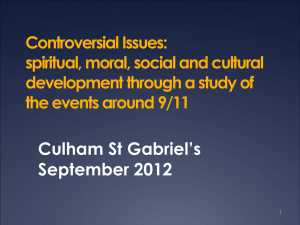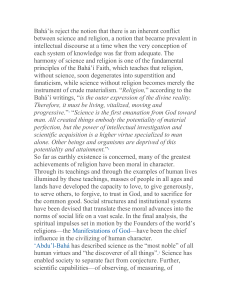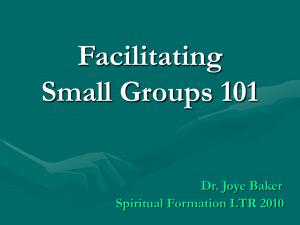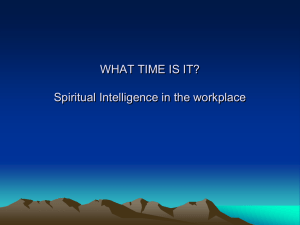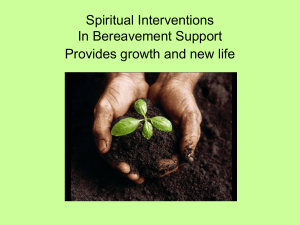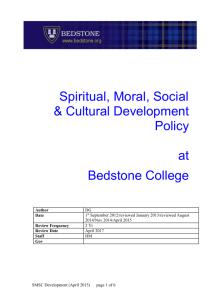Presentation - Culham St Gabriel`s
advertisement
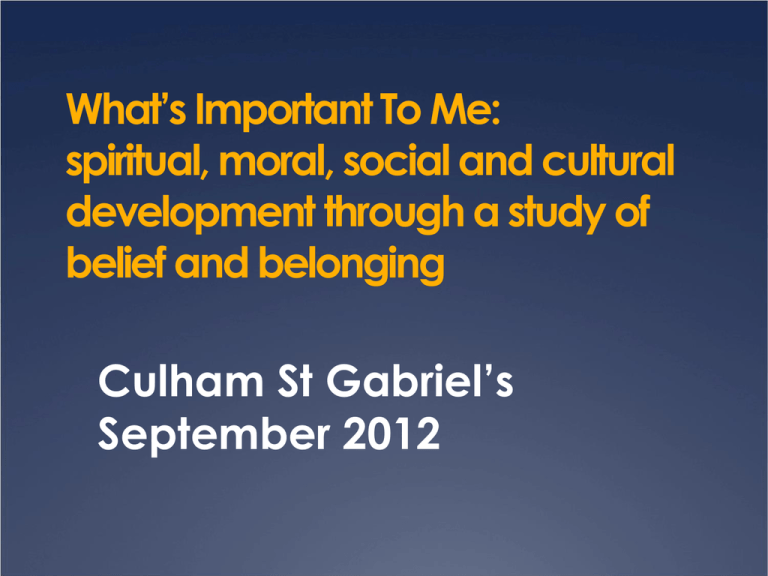
What’s Important To Me: spiritual, moral, social and cultural development through a study of belief and belonging Culham St Gabriel’s September 2012 Aims: to show how RE can take a lead in proving opportunities for pupils’ spiritual, moral, social and cultural development; to gain clarity on what might be meant by the key terms; to consider questions of belief and belonging in the RE classroom; to consider a case study of good practice in relation to a KS2 series of lessons – showing how elements of spiritual, moral, social and cultural development can be provided through lesson activities. Who R U? What more is there to you, than your name?’ BIRTHDAY tone of AGE friendly? voice: Where R U from? SHOUT or big or small? whisper? body language ! Character... facial expressions? sporty? physical / non-physical SMSCD: Subsidiary Guidance Issued To Inspectors January 2012 ‘Where a school does not provide the National Curriculum and RE, inspectors will need to fully explore the school’s reasons’; Defining smscd: see handout; Parent Engagement Policy. Ofsted Report: Transforming religious education The 2010 Ofsted ‘Long Report’ on RE: noted that, ‘in about six in ten of the schools visited, there were few opportunities for students to explore the more spiritual aspects of the subject. For example, they rarely engaged with challenging or evocative material drawn from religious and belief traditions that might stimulate more profound feelings or ideas.’ The Report stated that, ‘A positive contribution to spiritual development involves opportunities for pupils to: develop a sense of fascination about themselves and the world around them; explore and reflect on the more intangible and puzzling aspects of their experience; use imagination and creativity in their learning. It is these aspects of learning which were often weakest where the provision for RE was no better than satisfactory.’ (Ofsted, 2010, p.16) Spiritual Development: Signs of the following behaviour and/or attitudes are an indication that more or wider opportunities for spiritual development need to be provided: indifference to others, their beliefs, values and needs; indifference to reflection; over-concern with status and material rewards. Moral Development: Signs of the following behaviour and/or attitudes are an indication that more or wider opportunities for moral development need to be provided: narrow-mindedness; self-centredness. Social Development: Signs of the following behaviour and/or attitudes are an indication that more or wider opportunities for social development need to be provided: use of offensive language; refusal to accept responsibility for actions; disrespectful behaviour; disruptive behaviour; refusal to work or attend lessons. Cultural Development: Signs of the following behaviour and/or attitudes are an indication that more or wider opportunities for cultural development need to be provided: being dismissive or disrespectful of other people’s deeply held beliefs, values and convictions; indifference to cultural activities; ignorance of the damage that can be done by stereotyping and generalisation. What is ‘spiritual development’ and what is its place in education? One approach to providing opportunities for pupils’ spiritual development is to think of spiritual development in terms of a person’s inner life (sense of awe, wonder, curiosity etc) and the ways in which a spiritual life might be outwardly expressed (in lack of concern for status, for example). Some also talk of downward and upward and expressions of spirituality, i.e., ‘down-to-earth’ and ‘aspirational’. What is ‘spiritual development’ and what is its place in education? What are the signs of a ‘spiritually developed’ person? Such a person might be observed, for example (inner life): engaging in activities which involve listening, reflecting, puzzling, searching for truth; developing an understanding of their own feelings, likes and dislikes; developing personal beliefs and values; showing insights into deep questions about life, change and death; engaging in prayer, meditation or worship. What is ‘spiritual development’ and what is its place in education? What are the signs of a ‘spiritually developed’ person? Such a person might be observed, for example (outward expression): engaging in activities which involve questioning, valuing, creating, envisioning, empathising, imagining; immersing themselves in constructive work, sacrificing immediate self- interest; developing an understanding of their relationships with those near and far; enjoying exploring diversity and difference; being involved with a faith or belief community . ART & DESIGN: Inner Life reflecting on the power and mystery of art to create feelings of sadness, anger, fear, humour, happiness in both figurative and abstract work; responding personally through their own feelings and preferences to paintings, sculptures, artefacts and buildings; developing beliefs about the role of art and design in human life and society; making connections between examples of art and themes of life, change and death. ART & DESIGN: Outward Expression valuing art and design from other cultures and times; investigating art from unfamiliar cultures – why was it made, what was its purpose?; creating their own art and designs and developing their understanding of symbolism to communicate ideas; exploring and experimenting with ideas, materials, and processes; making connections between art and design from different cultures with their own work; enjoying the diversity and difference in art and design. What’s Important To Me: SMSCD opportunities in a KS2 scheme of learning for RE Identify smscd in the scheme of learning: spiritual: moral: social: cultural: Some values in religion/belief The (Para-) Olympic Values Justice Respect / Fair Play Love Excellence Forgiveness Friendship Courage Courage Duty Determination Self-sacrifice Inspiration Mercy Equality
